Hearing Aid Evaluations, Sales & Service
If you need hearing aids for the first time or want to replace the ones you already have, our experienced audiologists will make sure you find the ones that are right for your hearing loss and your budget.
What to expect at a hearing aid evaluation
At your hearing aid evaluation appointment, one of our audiologists will:
- Explain how hearing aids work and how they can improve your hearing and communication
- Discuss the benefits and limitations of hearing aids and communication devices so you can make an informed decision about the option that is best for you
- Ask questions about your lifestyle, abilities, activity level, communication goals and the type of listening situations you need help in
- Discuss the cost of the hearing aids
- Discuss the range of hearing aid technologies that match your unique needs and budget
- Describe hearing aid styles, models, cosmetic preferences and technical characteristics
- Evaluate what accessories such as remote controls, blue tooth and smart phone compatibility, etc. will be right for you
- Prescribe the hearing aid that’s best for you from the product lines offered by all major hearing aid manufacturers
- Discuss the funding available for hearing aids and communication devices through various Ontario and federal programs. We can help identify if you are eligible for funding and assist you with any application process that may be necessary.
If you decide to order hearing aids from Baycrest after your evaluation, we will:
- Take impressions of your ears (if appropriate)
- Place your order with the manufacturer
- Book your fitting and follow-up appointment
How to book a hearing aid evaluation
If you’ve already had a hearing test and want to book a hearing aid evaluation, simply call us at 416-785-2476 or Email us at hearing@baycrest.org
Hearing aid fitting and services
At your hearing aid fitting, our audiologist will program the hearing aids to meet your amplification needs and to make sure you:
- Understand how to best use your hearing aids
- Know how to clean and maintain them
- Are comfortable with the sound quality
- Gain a realistic understanding of potential benefits and limitations
- Ensure they are meeting your amplification needs
- We offer a 60-day trial period, 3 year service warranty, and 2 year loss and damage warranty on all hearing aids.
During the 60-day trial period, we strongly recommend you return for follow-up visits to let us know how your hearing aids are performing and to see if any adjustments, fine-tuning or counselling and education are necessary.
We also recommend you return for an annual hearing test and hearing aid check-up. Regular visits help monitor your hearing loss, assess the effectiveness of your hearing aids, and provide strategies for overcoming any challenges you may encounter.
We also offer custom-made swim plugs and noise protection, hearing aid accessories, and batteries.








How to book a hearing aid evaluation
If you’ve already had a hearing test and want to book a hearing aid evaluation, simply call us at 416-785-2476 or Email us at hearing@baycrest.orgGetting the most out of your hearing aid
Please click here to download the brochure of how to get the most out of your hearing aid.Types of hearing aids
-
Behind the Ear (BTE)
Behind The Ear (BTE)

Behind-the-ear (BTE) instruments have a plastic casing that rests behind the ear and houses the device’s technology. A clear plastic tube then directs amplified sound into an earmold inside the ear canal.
-
Receiver-In-Canal (RIC)
Receiver-In-Canal (RIC)
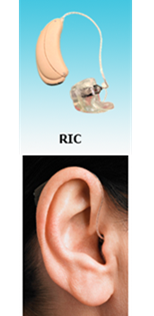
Receiver-in-the-canal (RIC) instruments are small and discreet, but may not be suitable for everyone. They can be fitted in the ear canal either with a custom-made eartip or a standard dome
-
Behind the Ear (BTE) with SLIM TUBE
Behind The Ear (BTE) with SLIM TUBE
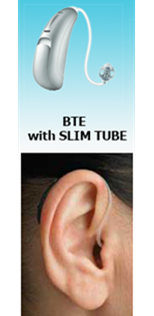
Behind-the-ear instruments with slim tubes are more discreet than the standard BTE hearing aids with earmolds. They can be fitted into the ear canal either with a custom-made eartip or a standard dome.
-
Completely-In-Canal (CIC)
Completely-In-Canal (CIC)
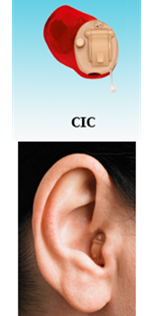
Completely-in-the-canal (CIC) instruments fit entirely in the ear canal. Only the head of a tiny plastic line, with which you remove the instrument, shows above the canal.
-
In-The-Ear (ITE)
In-The-Ear (ITE)
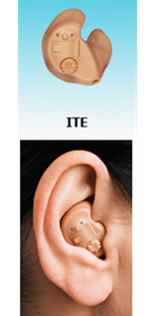
In-the-ear (ITE) instruments house their technology components in a custom-formed earmold that fits within the outer portion of the ear.
-
In The Canal (ITC)
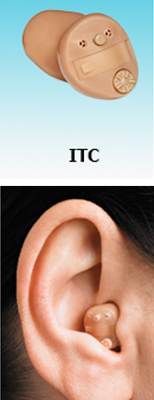
In-the-canal (ITC) instruments feature an earmold that fits down into the ear canal and a smaller portion that faces out into the outer ear.
Rechargeable Hearing Aids
Rechargeable hearing aids are now available as an option for those who have difficulty changing batteries, or who prefer not to have disposable batteries. Depending on the device, the hearing aid may also be able to interchangeably use regular, disposable hearing aid batteries when desired, such as when a person travels and does not wish to take the charger along.
The rechargeable batteries last approximately one year. When the hearing aids are removed from the ears at night, they are simply placed into the special charger and are ready for use the next day.
At this time, rechargeable hearing aids are only available in the Receiver-in-the-Ear and Behind-the-Ear styles.
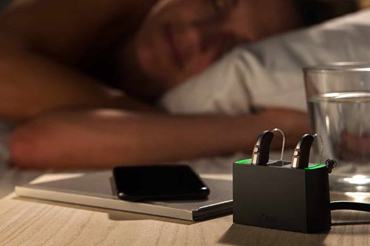
Do You Have Single-Sided Deafness and Feel Left Out in Some Situations?
When you have one deaf ear that is unaidable you may hear pretty well in one-to-one conversation in quiet, or when the person speaking is on your better side, but you probably have difficulty when conversation originates on the side of the poor ear. People with this problem become accustomed to positioning themselves so that the poor ear is away from the speaker.
However, many people find there are times this is not possible. For example, a meeting around a boardroom table where speakers are on both sides of the listener, or a cab driver with deafness in the right ear (next to the passenger). In social situations it is not always possible to have the entire group in a favourable position and conversation on the poor side is missed. There can be safety concerns when crossing the street.
If you experience problems due to deafness on one side, there is help. CROS hearing aids pick up the sound on the deaf side and re-route it to the better hearing ear. Hence the acronym “CROS” – Contralateral Routing of the Signal. While CROS hearing aids do not restore your ability to hear in the poor ear itself, they do make you aware of the sound or conversation coming from that side of you.

If you have hearing loss in your better ear, amplification can be provided through the instrument on that side, so that you have pick up of sound on the deaf side and amplification of all sound on the better side. This arrangement is known as BICROS.